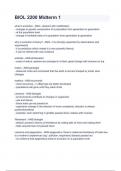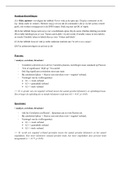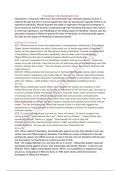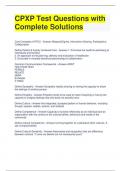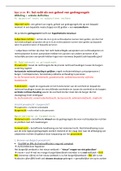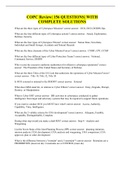Course model
The overall course model for this course focuses on where adaptation comes from and how
an organization can manage the process of adaptation by coming up with the right kind of
adaptations that fit the environment.
If we look at the model, an organization starts with determining where they want to go –
strategic intent – and end with the actual adaptation –the actual change and innovation in
terms of new products or services. In the middle, they are focusing on selecting the
adaptation –making sense of the innovation – which is done by the capabilities and
competencies in the bottum.
,Morgan (2006) Images of Organization
The first paper of this course is from Morgan (2006) and centers why adaptation is necessary
for organizations. It focuses on the evolutionary theory that helps to understand and
identify that not all change is internally decided, but the environment does also trigger
adaptation. In other words, Morgan (2006) argued that organizations need to be open to
the environment to understand the inputs from the environment in order to change.
Specifically, the paper built upon the idea that data does not support the historically
mechanic view on organizational adaptation and its beliefs that all change was internally
decided within organizations as closed systems, given that this mechanic view of closed
systems overlooks the effect and triggering of the environment (i.e., the decline and
maturity within the product-life cycle that is caused by the environment instead of internal
decision-making since not any company would decide to decline its sales).
That is, data and this paper point to an organic view on organizational adaptation in which
there is organizations should act as open system by taking into account the external forces
of the environmental effect that may cause organizations to adapt since organizations are
sensitive to the outside pressure that comes from the environment (permeable boundaries).
By focusing on the significance of the environmental effect, the evolutionary theory helps us
to understand why some organizations successfully adapt – because they correctly
understand their environment – and why some organizations get it wrong – they do not
correctly understand their environment very well.
Important to note is that this organic view of organizations as open systems and its
associated evolutionary theory are becoming more and more important because of the
increasing competitive pressure within almost all industries that causes volatile market
leadership.
,But can every firm successfully adapt?
No! First, not every organization is able to adapt - such as Blackberry and Nokia – and,
second, not every adaptation on itself is enough to be a successful adaptation – the
Microsoft Zoom that was technologically superior to the iPod but completely failed.
Contingency theory (success of adaptation is contingent on match with situation)
Exactly the second fact that not every adaptation on itself is successful, underscores the
significance of the environment given that there seems to be match between the adaptation
and the situation which determines the success of the adaptation. This crucial match
between the situation and the adaptation that increases or decreases the success of the
adaptation is known as the contingency theory.
Specifically, the contingency theory in sense argues that not every company can adapt, but
when the organization can adapt, adapting on itself is not enough, given that the adaptation
itself has to match with the situation. Hence, by ensuring a good match between the
adaptation and the situation, the adaptation becomes successful and will positively
influences the performances, whereas an adaptation without a match to the situation will
negatively influence the performance and success of the adaptation.
,Abatecola, G. (2014). Research in organizational evolution. What comes next?
This paper of Abatecola (2014) also focusing on the process of adaptation that is associated
with the evolutionary theory (evolution) by arguing for a more co-evolutionary theory of
adaptation in which the interplay between the deterministic and voluntaristic process of
adaptation stands central.
Specifically, this paper agrees on the environmental effect derived from the evolutionary
theory by proposing that the process of adaptation is deterministic, but argues that
adaptation simultaneously is voluntaristic since firms proactively try to read and forecast
environmental change within its internal selection environment.
In other words, Abatecola argues that, besides the environmental effect, firms’ action also
determine adaptation (relates back to internally decided change of mechanic view) and
therefore points to a co-evolutionary – instead of evolutionary - perspective on adaptation
(perspective of interplay between deterministic and voluntaristic perspective).
In other words, the article in particular is about two distinctive perspectives on adaptation:
1. Deterministic perspective: reactive response in which organizations change when
the environment changes (environment determines changes in which the firm reacts
when the fire alarm goes off)
2. Voluntaristic perspective: proactive organizational response by anticipating on what
will happen with environment and coming up with variations to that prediction (the
firm is predicting when the fire alarm will go off)
Linkage of these perspectives to the process of variation, selection and retention
1. Linking the VSR-metaphor to the deterministic perspective (evolutionary theory)
If we relate the deterministic perspective to the VSR-metaphor, we should focus on the
external selection environment, in which variation is about the situation in which the
environment demands change, and the organizations in response to that calling demand
comes up with novel ideas that can meets the changing demands.
2. Linking the VSR-metaphor to the voluntaristic perspective
,If we, on the other hand, link this VSR-metaphor to the voluntaristic perspective, we should
focus on the internal selection environment, in which the organizations is already reading
and forecasting the environment to be able to determine how the organization can already
make sense of its external environment by coming up with novel ideas that will meet the
new demands before the environment has already changed.
Dialectical thinking and co-evolution by interplay between internal and external
In sum, Abatecola (2014) argues that organizational adaptation is not solely deterministic or
solely but voluntaristic, but is a dynamic process in which the interplay between these two
perspectives and its associated external selection environment and internal selection
environment is crucial to be able to survive (known as dialectical thinking)
That is, determinism and voluntarism (strategic choice) can be seen as two intertwined
forces driving organizational adaptation, in which organizational adaptation depends on the
interplay between internal environment and external environment (this, however, is quite
difficult to match)
,Burgelman (1991)
The paper of Burgelman (1991) argues that firms within its strategic intent – instead of the
focusing on the content of adaptations - rather should focus on its abilities to adapt by
looking into their strategizing processes.
According to Burgerlman (1991), unlikely events with huge impact like black swans are
increasing in today’s world due to the interconnectedness of the global economy in which
small changes already can cause huge impacts because of the interrelations (butterfly
effect).
As a result, interconnected markets turn into a hyper competitive markets in which it is
difficult to predict the content of adaptations within the strategic intent. Consequently,
focusing on the abilities within the strategic intent by looking at the process of strategizing
to adapt becomes more and more important according to Burgelman (1991).
In general, there are two types of processes of strategizing according to Burgelman (1991)
1. Induced strategizing (incremental): top-down process in which the top management
articulates a strategy that holds narrow objectives and focuses on capabilities within
the scope of the existing strategy (reduces variation)
2. Autonomous strategizing (radical): bottum-up process in which multiple individuals
(usually not the top management team) articulate a strategy with undefined
objectives by focusing on activities outside the scope of the current strategy
(increases variation)
If we compare these two different types of strategizing processes, we can argue that:
- Induced strategizing can be seen as variation reducing, because its objectives
narrow the room for something new, whereas autonomous strategizing can be seen
as variation increasing because it offers more room for doing something new.
- Induced strategizing is more associated with incremental change that is useful for
likely events, whereas autonomous strategizing is more associated with radical
change that is useful for unlikely events.
That is, if we relate this two types of strategizing processes to the emergence of
hypercompetitive markets due to the increasing impact of unlikely events like black swans
,within the interconnected markets of today’s global economy, autonomous strategizing is
becoming more important because this type of strategizing process does increase the
variation that is useful for dynamic markets and unlikely events
Burgelman (1991), however, argues that a balanced strategizing process in which induced
and autonomous strategizing are balanced is crucial to survive, because increasing the
degree of variation by an autonomous strategizing process by itself does not mean that the
right adaptation will be found.
Specifically, Burgelman (1991) argues that if the firm is focusing on an autonomous
strategizing process to increase its variation, this does not necessarily mean that this
variation increasing process will come with novel ideas related to its capabilities and past
successes.
That is, the main point of Burgelman (1991) is that firms within highly dynamic markets
should focus on its ability to adapt by looking into their process of strategizing, and in
particularly focus on autonomous strategizing processes to be able to increase its variation
for novel idea generating.
Yet, only focusing on innovation and renewal by autonomous strategizing processes is not
sufficient according to Burgelman (1991) since a balanced strategizing approach is needed
to survive and thrive in which induced strategizing processes elements ensure that the
adaptations are not straying too far from the objectives and past success of the firm to
ensure short-term viability.
In sum, firms need to combine the strategic context (what is going on within the
environment) with the structural context (what is going on within the organization) to both
take into account exploration (autonomous strategizing) and exploitation (induced
strategizing) by a balanced strategizing approach to ensure both future and short-term
viability.
, Feldman & Pentland, 2003
This paper does also dive into the internal selection environment by focusing on the routines
that determine the selection among novel ideas and potential adaptations. Specifically, the
paper argues that routines help to explain what an organization is actually able to in terms
of making sense of the external selection environment, based on its competencies and
capabilities.
What is a routine?
According to Feldman and Pentland (2003), a routine is a repetitive and recognizable
pattern of interdependent actions, that stays persistent over time, and can explain why
firms succeed or fail to react to changing conditions since routines enable or inhibit change.
Feldman and Pentland (2003), however, argued that because people are so much focused on
the stability and persistence of routines, existing research was missing out on the agency
aspect within routines (lack of agency).
Feldman and Pentland (2003), believed that agency was involved within routines since
people have to make choices about whether they act in way that links with routines or not,
which makes routines somewhat malleable (people within organizations can decide to act
different than its routines proposes).
As a result, Feldman and Pentland (2003), came up with a new framework that
acknowledges and focuses on routines dynamics by looking into the interaction between
the ostensive aspect of routines and the performative aspect of routines:
- Ostensive aspect of routines: refers to the actual idea of the routine in which the
demanded behavior of everyone within the organization is described (such as the
protocol firm alarms)
- performative aspect of routines: refers to the actual enactment of the routine in
which people can decide to not follow the guidelines and idea of the ostensive aspect
by acting differently (i.e., running instead of walking when the alarm goes off)
The overall course model for this course focuses on where adaptation comes from and how
an organization can manage the process of adaptation by coming up with the right kind of
adaptations that fit the environment.
If we look at the model, an organization starts with determining where they want to go –
strategic intent – and end with the actual adaptation –the actual change and innovation in
terms of new products or services. In the middle, they are focusing on selecting the
adaptation –making sense of the innovation – which is done by the capabilities and
competencies in the bottum.
,Morgan (2006) Images of Organization
The first paper of this course is from Morgan (2006) and centers why adaptation is necessary
for organizations. It focuses on the evolutionary theory that helps to understand and
identify that not all change is internally decided, but the environment does also trigger
adaptation. In other words, Morgan (2006) argued that organizations need to be open to
the environment to understand the inputs from the environment in order to change.
Specifically, the paper built upon the idea that data does not support the historically
mechanic view on organizational adaptation and its beliefs that all change was internally
decided within organizations as closed systems, given that this mechanic view of closed
systems overlooks the effect and triggering of the environment (i.e., the decline and
maturity within the product-life cycle that is caused by the environment instead of internal
decision-making since not any company would decide to decline its sales).
That is, data and this paper point to an organic view on organizational adaptation in which
there is organizations should act as open system by taking into account the external forces
of the environmental effect that may cause organizations to adapt since organizations are
sensitive to the outside pressure that comes from the environment (permeable boundaries).
By focusing on the significance of the environmental effect, the evolutionary theory helps us
to understand why some organizations successfully adapt – because they correctly
understand their environment – and why some organizations get it wrong – they do not
correctly understand their environment very well.
Important to note is that this organic view of organizations as open systems and its
associated evolutionary theory are becoming more and more important because of the
increasing competitive pressure within almost all industries that causes volatile market
leadership.
,But can every firm successfully adapt?
No! First, not every organization is able to adapt - such as Blackberry and Nokia – and,
second, not every adaptation on itself is enough to be a successful adaptation – the
Microsoft Zoom that was technologically superior to the iPod but completely failed.
Contingency theory (success of adaptation is contingent on match with situation)
Exactly the second fact that not every adaptation on itself is successful, underscores the
significance of the environment given that there seems to be match between the adaptation
and the situation which determines the success of the adaptation. This crucial match
between the situation and the adaptation that increases or decreases the success of the
adaptation is known as the contingency theory.
Specifically, the contingency theory in sense argues that not every company can adapt, but
when the organization can adapt, adapting on itself is not enough, given that the adaptation
itself has to match with the situation. Hence, by ensuring a good match between the
adaptation and the situation, the adaptation becomes successful and will positively
influences the performances, whereas an adaptation without a match to the situation will
negatively influence the performance and success of the adaptation.
,Abatecola, G. (2014). Research in organizational evolution. What comes next?
This paper of Abatecola (2014) also focusing on the process of adaptation that is associated
with the evolutionary theory (evolution) by arguing for a more co-evolutionary theory of
adaptation in which the interplay between the deterministic and voluntaristic process of
adaptation stands central.
Specifically, this paper agrees on the environmental effect derived from the evolutionary
theory by proposing that the process of adaptation is deterministic, but argues that
adaptation simultaneously is voluntaristic since firms proactively try to read and forecast
environmental change within its internal selection environment.
In other words, Abatecola argues that, besides the environmental effect, firms’ action also
determine adaptation (relates back to internally decided change of mechanic view) and
therefore points to a co-evolutionary – instead of evolutionary - perspective on adaptation
(perspective of interplay between deterministic and voluntaristic perspective).
In other words, the article in particular is about two distinctive perspectives on adaptation:
1. Deterministic perspective: reactive response in which organizations change when
the environment changes (environment determines changes in which the firm reacts
when the fire alarm goes off)
2. Voluntaristic perspective: proactive organizational response by anticipating on what
will happen with environment and coming up with variations to that prediction (the
firm is predicting when the fire alarm will go off)
Linkage of these perspectives to the process of variation, selection and retention
1. Linking the VSR-metaphor to the deterministic perspective (evolutionary theory)
If we relate the deterministic perspective to the VSR-metaphor, we should focus on the
external selection environment, in which variation is about the situation in which the
environment demands change, and the organizations in response to that calling demand
comes up with novel ideas that can meets the changing demands.
2. Linking the VSR-metaphor to the voluntaristic perspective
,If we, on the other hand, link this VSR-metaphor to the voluntaristic perspective, we should
focus on the internal selection environment, in which the organizations is already reading
and forecasting the environment to be able to determine how the organization can already
make sense of its external environment by coming up with novel ideas that will meet the
new demands before the environment has already changed.
Dialectical thinking and co-evolution by interplay between internal and external
In sum, Abatecola (2014) argues that organizational adaptation is not solely deterministic or
solely but voluntaristic, but is a dynamic process in which the interplay between these two
perspectives and its associated external selection environment and internal selection
environment is crucial to be able to survive (known as dialectical thinking)
That is, determinism and voluntarism (strategic choice) can be seen as two intertwined
forces driving organizational adaptation, in which organizational adaptation depends on the
interplay between internal environment and external environment (this, however, is quite
difficult to match)
,Burgelman (1991)
The paper of Burgelman (1991) argues that firms within its strategic intent – instead of the
focusing on the content of adaptations - rather should focus on its abilities to adapt by
looking into their strategizing processes.
According to Burgerlman (1991), unlikely events with huge impact like black swans are
increasing in today’s world due to the interconnectedness of the global economy in which
small changes already can cause huge impacts because of the interrelations (butterfly
effect).
As a result, interconnected markets turn into a hyper competitive markets in which it is
difficult to predict the content of adaptations within the strategic intent. Consequently,
focusing on the abilities within the strategic intent by looking at the process of strategizing
to adapt becomes more and more important according to Burgelman (1991).
In general, there are two types of processes of strategizing according to Burgelman (1991)
1. Induced strategizing (incremental): top-down process in which the top management
articulates a strategy that holds narrow objectives and focuses on capabilities within
the scope of the existing strategy (reduces variation)
2. Autonomous strategizing (radical): bottum-up process in which multiple individuals
(usually not the top management team) articulate a strategy with undefined
objectives by focusing on activities outside the scope of the current strategy
(increases variation)
If we compare these two different types of strategizing processes, we can argue that:
- Induced strategizing can be seen as variation reducing, because its objectives
narrow the room for something new, whereas autonomous strategizing can be seen
as variation increasing because it offers more room for doing something new.
- Induced strategizing is more associated with incremental change that is useful for
likely events, whereas autonomous strategizing is more associated with radical
change that is useful for unlikely events.
That is, if we relate this two types of strategizing processes to the emergence of
hypercompetitive markets due to the increasing impact of unlikely events like black swans
,within the interconnected markets of today’s global economy, autonomous strategizing is
becoming more important because this type of strategizing process does increase the
variation that is useful for dynamic markets and unlikely events
Burgelman (1991), however, argues that a balanced strategizing process in which induced
and autonomous strategizing are balanced is crucial to survive, because increasing the
degree of variation by an autonomous strategizing process by itself does not mean that the
right adaptation will be found.
Specifically, Burgelman (1991) argues that if the firm is focusing on an autonomous
strategizing process to increase its variation, this does not necessarily mean that this
variation increasing process will come with novel ideas related to its capabilities and past
successes.
That is, the main point of Burgelman (1991) is that firms within highly dynamic markets
should focus on its ability to adapt by looking into their process of strategizing, and in
particularly focus on autonomous strategizing processes to be able to increase its variation
for novel idea generating.
Yet, only focusing on innovation and renewal by autonomous strategizing processes is not
sufficient according to Burgelman (1991) since a balanced strategizing approach is needed
to survive and thrive in which induced strategizing processes elements ensure that the
adaptations are not straying too far from the objectives and past success of the firm to
ensure short-term viability.
In sum, firms need to combine the strategic context (what is going on within the
environment) with the structural context (what is going on within the organization) to both
take into account exploration (autonomous strategizing) and exploitation (induced
strategizing) by a balanced strategizing approach to ensure both future and short-term
viability.
, Feldman & Pentland, 2003
This paper does also dive into the internal selection environment by focusing on the routines
that determine the selection among novel ideas and potential adaptations. Specifically, the
paper argues that routines help to explain what an organization is actually able to in terms
of making sense of the external selection environment, based on its competencies and
capabilities.
What is a routine?
According to Feldman and Pentland (2003), a routine is a repetitive and recognizable
pattern of interdependent actions, that stays persistent over time, and can explain why
firms succeed or fail to react to changing conditions since routines enable or inhibit change.
Feldman and Pentland (2003), however, argued that because people are so much focused on
the stability and persistence of routines, existing research was missing out on the agency
aspect within routines (lack of agency).
Feldman and Pentland (2003), believed that agency was involved within routines since
people have to make choices about whether they act in way that links with routines or not,
which makes routines somewhat malleable (people within organizations can decide to act
different than its routines proposes).
As a result, Feldman and Pentland (2003), came up with a new framework that
acknowledges and focuses on routines dynamics by looking into the interaction between
the ostensive aspect of routines and the performative aspect of routines:
- Ostensive aspect of routines: refers to the actual idea of the routine in which the
demanded behavior of everyone within the organization is described (such as the
protocol firm alarms)
- performative aspect of routines: refers to the actual enactment of the routine in
which people can decide to not follow the guidelines and idea of the ostensive aspect
by acting differently (i.e., running instead of walking when the alarm goes off)


